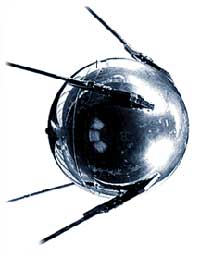Sputnik
Sputnik 1
The first artificial satellite, Sputnik 1, was launched on 4 October 1957. The satellite contained two radio transmitters designed so that their signals could be received easily by radio amateurs. It weighed just 183.9 lbs (83.6 kg), and orbited in 96-98 minutes at 18,000 mph (29,000 kph).
The radio transmitter on-board broadcasted at 20.005 and 40.002 MHz. The signal was monitored by amateur radio operators throughout the world. On October 26th, 1957, the batteries ran out and the orbit decayed until it re-entered the atmosphere on January 4th, 1958, burning up.
Sputnik itself did not make any sound. The signal worked like the rekeying of a morse radio key, thus the pitch depends on the pitch set by the ham radio operator’s equipment.
Sputnik 2
Just 32 days later, Sputnik 2 launched on November 3, 1957, carrying the dog Laika, and weighing 1,100 lbs (508.3 kg). This meant that it was big enough to be a warhead. Laika only survived a few hours due to unexpected overheating, but the satellite remained in orbit for 162 days.
Sputnik Timeline:
- 1954 -- As a second part (behind the Antartica efforts), of the IGY NSF budget was to launch an experimental satellite (draft resolution 3rd week of August, 1954, adopted 25 Sept by IUGG). Satellites had been discussed at least as early as 1952 at Lincoln Labs, there was a 1954 RAND study
- 1955 -- Soviet intention to launch satellite for International Geophysical Year
- 1956 -- Eisenhower announces US intention to launch satellite for International Geophysical Year
- 1957, 4 October -- Sputnik launched
- 18 October -- J F Kennedy speech at University of Florida re “age of Sputnik” calls for a civilian space agency, and toughening of science standards in U.S. schools
- 3 November -- Sputnik 2 launched carrying the dog Laika. Sputnik 2 weighs 508.3 kg/ 1,100 lbs
- 7 November -- President Eisenhower appoints Killian the first Special Assistant to the President for Science and Technology aka Presidential Science Adviser
- Late November -- Senator Lyndon Johnson and Richard Russell open an investigation and Johnson is chairing Senate hearings “Inquiry into Satellite and Missile Programs.”
- 6 December -- Vangard rocket lifts 4 feet, falls and explodes. 1.3 kg satellite (“derisively called, ‘the grapefruit’ falls into the bushes and begins transmitting signals)
- 1958, Project 137 (physics summer program)
- February -- ARPA, later DARPA created
- 2 September -- National Defense Education Act passed, including Judd amendment establishing the Federal Student Loan Program
- 1959, February -- US launches first successful satellite
- December -- Physicists (among them IEEE Fellow Charles Townes, inventor of laser and later a Nobel Laureate) meet in Los Alamos and launch JASON as a summer study program
- 1960 (FY) -- DOD appropriates special $17 million
Sources:
Chertok, Rockets and People, Volume 2: Creating a Rocket Industry
Dienesch, Eyeing the Red Storm
Edwards, Computers and the Politics of Discourse
Leslie, Cold War and American Society
Needell, Science, Cold War, and the American State
Stever, My Life in Science and Technology
Wolfe, Competing with the Soviets

